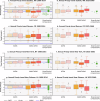GARD-LENS: A downscaled large ensemble dataset for understanding future climate and its uncertainties
- PMID: 39695257
- PMCID: PMC11655549
- DOI: 10.1038/s41597-024-04205-z
GARD-LENS: A downscaled large ensemble dataset for understanding future climate and its uncertainties
Abstract
This article introduces the Generalized Analog Regression Downscaling method Large Ensemble (GARD-LENS) dataset, comprised of daily precipitation, mean temperature, and temperature range over the Contiguous U.S., Alaska, and Hawaii at 12-km, 4-km, and 1-km resolutions, respectively. GARD-LENS statistically downscales three CMIP6 global climate model large ensembles, CESM2, CanESM5, and EC-Earth3, totaling 200 ensemble members. GARD-LENS is the first downscaled SMILE (single model initial-condition large ensemble), providing information about the role of internal climate variability at high resolutions. The 150-year record of this large ensemble dataset provides ample data for assessing trends and extremes and allows users to robustly assess internal variability, forced climate signals, and time of emergence at high resolutions. As the need for high resolution, robust climate datasets continues to grow, GARD-LENS will be a valuable tool for scientists and practitioners who wish to account for internal variability in their future climate analyses and adaptation plans.
© 2024. The Author(s).
Conflict of interest statement
Competing interests: The authors declare no competing interests.
Figures









References
-
- Eyring, V. et al. Overview of the Coupled Model Intercomparison Project Phase 6 (CMIP6) experimental design and organization. Geosci Model Dev9(5), 1937–1958, 10.5194/gmd-9-1937-2016 (2016).
-
- Edwards, P. N. History of climate modeling. Wiley Interdiscip Rev Clim Change2(1), 128–139, 10.1002/wcc.95 (2011).
-
- McGuffie, K. & Henderson-Sellers, A. Forty years of numerical climate modelling. International Journal of Climatology21(9), 1067–1109, 10.1002/joc.632 (2001).
-
- Hawkins, E. & Sutton, R. The potential to narrow uncertainty in regional climate predictions. Bull Am Meteorol Soc90, 1095–1107, 10.1175/2009BAMS2607.1 (2009).
-
- Deser, C., Phillips, A., Bourdette, V. & Teng, H. Uncertainty in climate change projections: The role of internal variability. Clim Dyn38(3–4), 527–546, 10.1007/s00382-010-0977-x (2012).
Grants and funding
LinkOut - more resources
Full Text Sources
Research Materials

